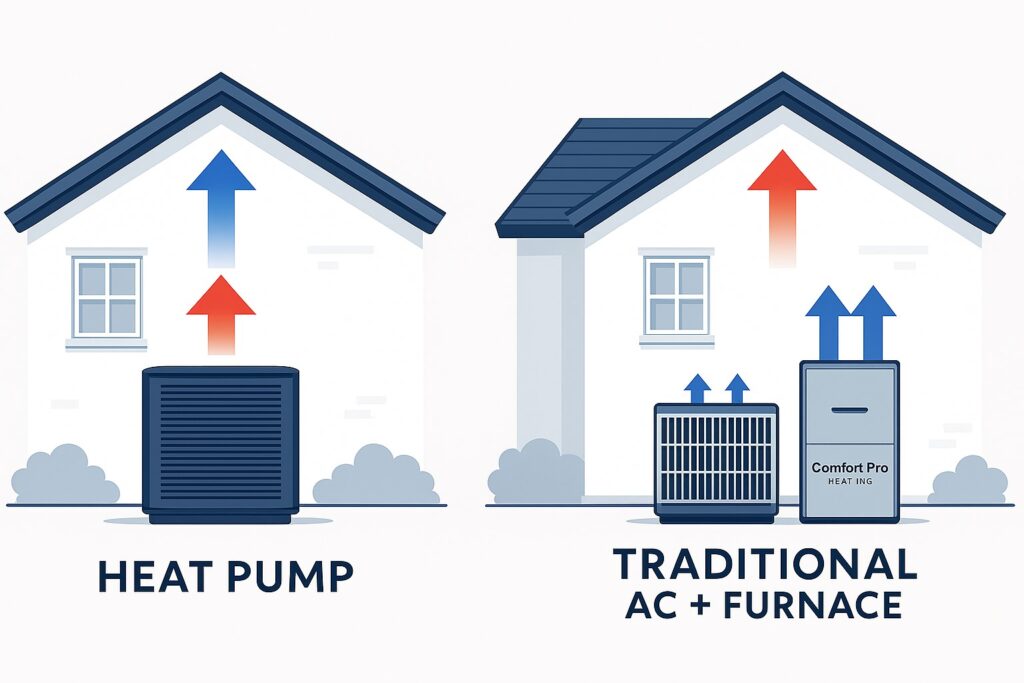Heat Pump vs. Traditional AC: What’s the Difference and Why More Homeowners Are Switching
As energy efficiency and sustainability become top priorities for homeowners, the conversation around heat pumps versus traditional HVAC systems is gaining momentum—especially with new incentives like the HEEHRA program. But what exactly is a heat pump? Why is it called that? And how can you tell if your home has one?
When Were Heat Pumps Invented?
The heat pump isn’t new. The technology dates back to 1856, when Austrian engineer Peter von Rittinger conceptualized it. Modern air-source heat pumps became more commercially viable in the 1940s and 1950s, but it wasn’t until the 1970s energy crisis that they began gaining popularity in the U.S., especially in southern climates.
What Is a Heat Pump and Why the Name?
Despite the name, a heat pump provides both heating and cooling. The term comes from its ability to “pump” heat from one place to another. In summer, it removes heat from inside your home—just like an air conditioner. In winter, it pulls heat from the outside air and transfers it indoors.
It’s not creating heat—it’s moving it. That’s what makes it so efficient.
Not sure what’s best for your home?
Let’s walk through it together-
Comfort Pro Heating & Cooling proudly serves Clovis, Fresno, and all the surrounding Central Valley. We’ll help you make a system check or get a free quote.
Traditional HVAC System: AC and Furnace
A standard setup in many U.S. homes includes a central air conditioner for cooling and a gas or electric furnace for heating. These systems are separate units, usually with a shared air handler or blower.
Comfort Pro installs both types of systems, and we walk customers through the pros and cons based on their home, climate, and energy goals.

How to Tell What You Have: Heat Pump or Traditional AC?
Here are three simple ways to determine what kind of system you have:
- Check the outdoor unit label. Look for terms like “heat pump,” “HP,” or model numbers ending in “HP.”
- Look for a reversing valve. Heat pumps include a valve that allows the system to switch between heating and cooling. An HVAC technician can easily confirm this.
- Test the system. Set your thermostat to heating mode. If the outdoor unit is running during heating, it’s a heat pump. In a traditional system, the outdoor AC unit remains off while the furnace handles heating.
Are Heat Pumps or Traditional ACs More Common?
Traditional AC and furnace systems are still more common in many parts of the U.S., especially in colder regions where natural gas is readily available and inexpensive. But the trend is shifting.
In 2020, approximately 38 percent of new single-family homes were built with heat pumps, up from 23 percent in 2000. In the South, over 80 percent of new homes now use heat pumps. States like California are pushing for all-electric homes, making heat pumps the default.
Source: National Association of Home Builders (NAHB)
Why Are People Switching to Heat Pumps?
In addition to combining heating and cooling in one system, heat pumps are:
- Up to 50 percent more efficient than electric resistance heating
- Saving homeowners $300 to $1,000 per year depending on previous system and fuel type
- Cleaner, because they do not rely on combustion
- Eligible for federal rebates through the HEEHRA program
According to Rewiring America, many families switching from propane or gas heating to electric heat pumps save hundreds annually—and thousands more when rebates are applied.
Top Heat Pump Brands
If you’re considering a new HVAC system, here are some of the most trusted heat pump manufacturers:
- Trane – XV20i Heat Pump
- Carrier – Infinity 24 Heat Pump
- Mitsubishi Electric – Zoned Comfort Solutions
- Daikin – Inverter Heat Pumps
- Bosch – IDS 2.0 Inverter Heat Pump
These brands offer excellent efficiency, long-term reliability, and support.
HEEHRA Program: Rebates for Heat Pump Systems
The High-Efficiency Electric Home Rebate Act (HEEHRA) is a federal program designed to help households transition from fossil fuel appliances to high-efficiency electric systems like heat pumps.
Here’s what it includes:
- Up to $8,000 in upfront rebates for qualified heat pump installations
- Additional rebates for electrical panel upgrades and weatherization
- Income-based eligibility tied to the area’s median income
Learn more at Rewiring America’s IRA Calculator
Download a HEEHRA Flyer and learn more about the program.
Installing What’s Right for Your Home
At Comfort Pro Heating & Cooling, we install both high-efficiency heat pump systems and traditional AC/furnace combinations, depending on the needs of your home and your comfort priorities. We help you compare options based on energy use, climate, and long-term cost — without pushing one system over the other.
If you’re not sure what type of system you have, or whether a heat pump is the right fit, our team can evaluate your setup and walk you through your options. We also help local homeowners apply for any available rebates, including HEEHRA.
Comfort starts next door — and we’re here to help you make the best choice for your home, budget, and long-term comfort.
Ready to switch to a heat pump?
Comfort Pro
Heating & Cooling
